PsychNewsDaily Publishers
100 Summit Drive
Burlington, MA, 01803
Telephone: (320) 349-2484
PsychNewsDaily Publishers
100 Summit Drive
Burlington, MA, 01803
Telephone: (320) 349-2484
Cat-safe houseplants include Spider Plant, Areca Palm, Boston Fern, and Calathea. These non-toxic plants enhance indoor aesthetics while ensuring feline health and safety.

Bringing plants indoors adds color and a little spark of life, but honestly, it gets tricky if you’ve got a curious cat roaming around. So many popular houseplants can be risky if your cat chews on them. Picking the right ones really matters. You can still enjoy a lush indoor garden and not stress about your cat’s safety—just choose plants that are totally non-toxic.
This guide shows you a bunch of safe options that brighten up your place while keeping your cat out of trouble. From leafy greens to blooming favorites, you’ll see how simple it is to create a cozy, cat-friendly home.
You’ll also get a few tips on why safe plants matter and how to design an indoor garden that works for both you and your cat.
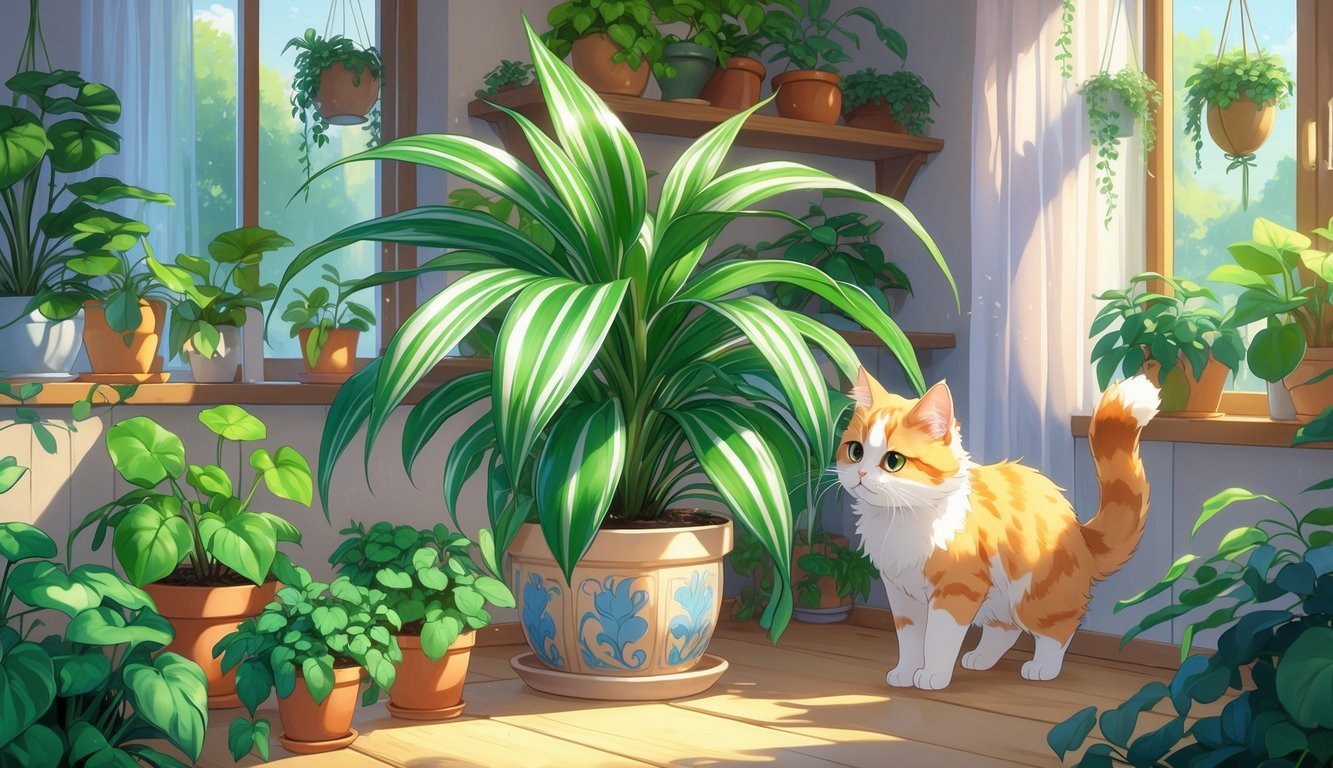
Go ahead and add a spider plant to your space—it won’t hurt your cat. Even if your cat gets curious and takes a bite, this plant is totally safe.
Spider plants don’t ask for much care. They thrive in indirect light and can handle a little neglect, so they’re perfect if you’re sometimes forgetful.
The long, arching leaves always seem to catch a cat’s attention. If your cat likes to bat at them or chew, maybe put the plant somewhere it won’t get destroyed but you can still enjoy it.
Spider plants grow little “baby” plants, or spiderettes, that hang down. You can leave them or snip them off to tidy things up.
Stick this plant on a shelf, hang it up, or let it sit in a pot on the floor. However you style it, you get that fresh green look without risking your cat’s health.
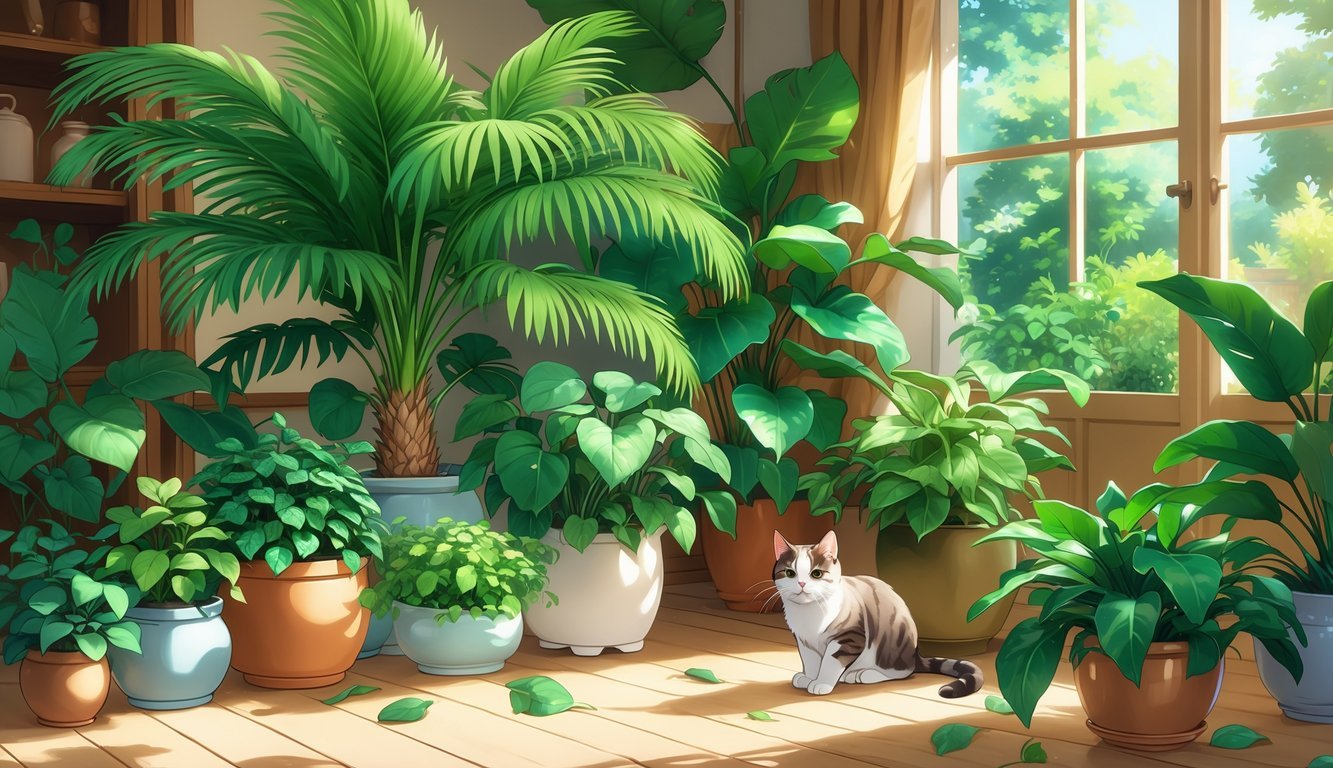
Areca Palm, sometimes called butterfly or golden cane palm, is a great pick if you live with cats. Your cat can chew on the leaves and stay perfectly fine.
Its long, feathery fronds bring a tropical vibe into your home. People love how it can brighten up a dull corner and even act as a natural room divider.
Keep this palm in bright, indirect light and make sure the soil is just a bit moist. Don’t let it get soggy, though—check before you water.
Since it’s non-toxic, you can set it anywhere your cat likes to wander. Even if your cat nibbles, you won’t have to worry.
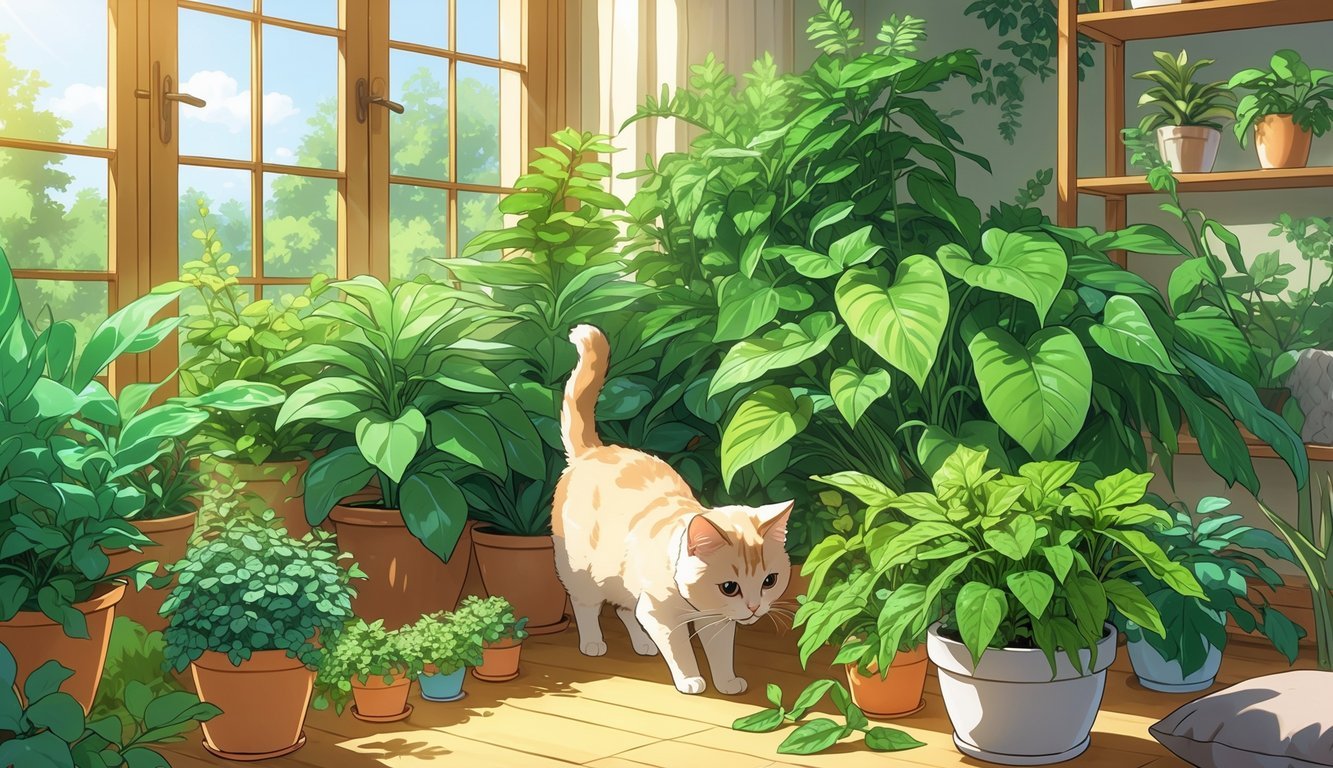
Boston Fern is a safe bet for cat owners. Unlike some ferns, this one won’t put your pet at risk if they brush up or take a bite.
It’s got soft, feathery fronds that instantly liven up a room. Try putting it on a shelf, in a hanging basket, or on the floor if your cat isn’t a digger.
Boston Ferns like indirect light and a bit of humidity. Bathrooms or kitchens work well, or just mist the leaves now and then.
You don’t need to give it direct sun. Water when the soil feels a bit dry, and it’ll stay green and healthy.
Boston Ferns are safe and pretty, so they’re a solid choice if you want that classic houseplant look without stress.

Parlor Palm makes plant care easy. It’s safe for cats, so you can relax if your pet takes a little nibble.
You can grow it in low to medium light, which is handy if your place doesn’t get a ton of sun. It grows slowly, so you won’t be repotting it all the time.
The plant might reach a few feet tall indoors, but usually it stays on the smaller side. Those soft, green fronds give your home a natural, laid-back vibe.
It doesn’t need bright light or constant attention. Just water when the top soil feels dry and keep it out of harsh sun.
If you want a classic, cat-safe plant that’s low effort, Parlor Palm is a great choice.

Add a Bamboo Palm and you won’t have to worry about your cat. The ASPCA says it’s non-toxic, so it’s a smart pick for curious pets.
Bamboo Palm, or Reed Palm, grows tall and brings a lush, tropical feel to your place. Indoors, it can reach a few feet, which is nice for filling up empty corners.
It prefers bright, indirect light and consistent moisture. Don’t let the soil dry out completely, but don’t drown it either.
If your cat bats at the leaves, no big deal. Still, maybe keep it away from wild play to avoid broken stems.
Bamboo Palm also helps clean the air, so it’s a win for you and your cat.
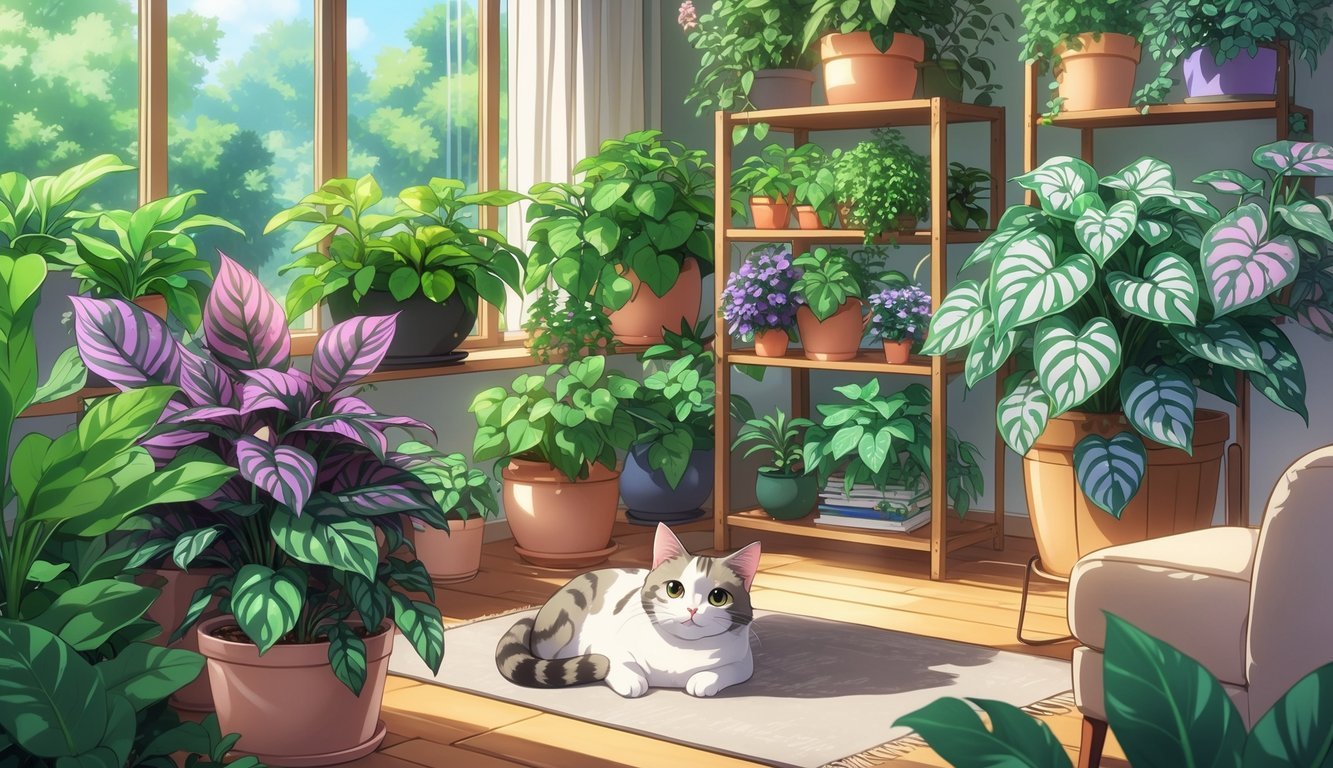
Calathea is totally safe for cats. The ASPCA and vets say it’s non-toxic—even for dogs and horses, if you have a menagerie at home.
These plants are famous for their patterned leaves, which come in all sorts of shapes and colors. You might like the Rattlesnake Plant, Medallion, or Peacock Plant—each one adds a unique look.
Calathea leaves sometimes move during the day, which is called nyctinasty. It’s a neat feature, and your cat might find it interesting too.
Give Calathea medium to low light and keep the soil evenly moist. Higher humidity keeps the leaves looking good and less tempting for your cat to snack on.
If you want a plant that’s both beautiful and safe, Calathea is a solid pick.
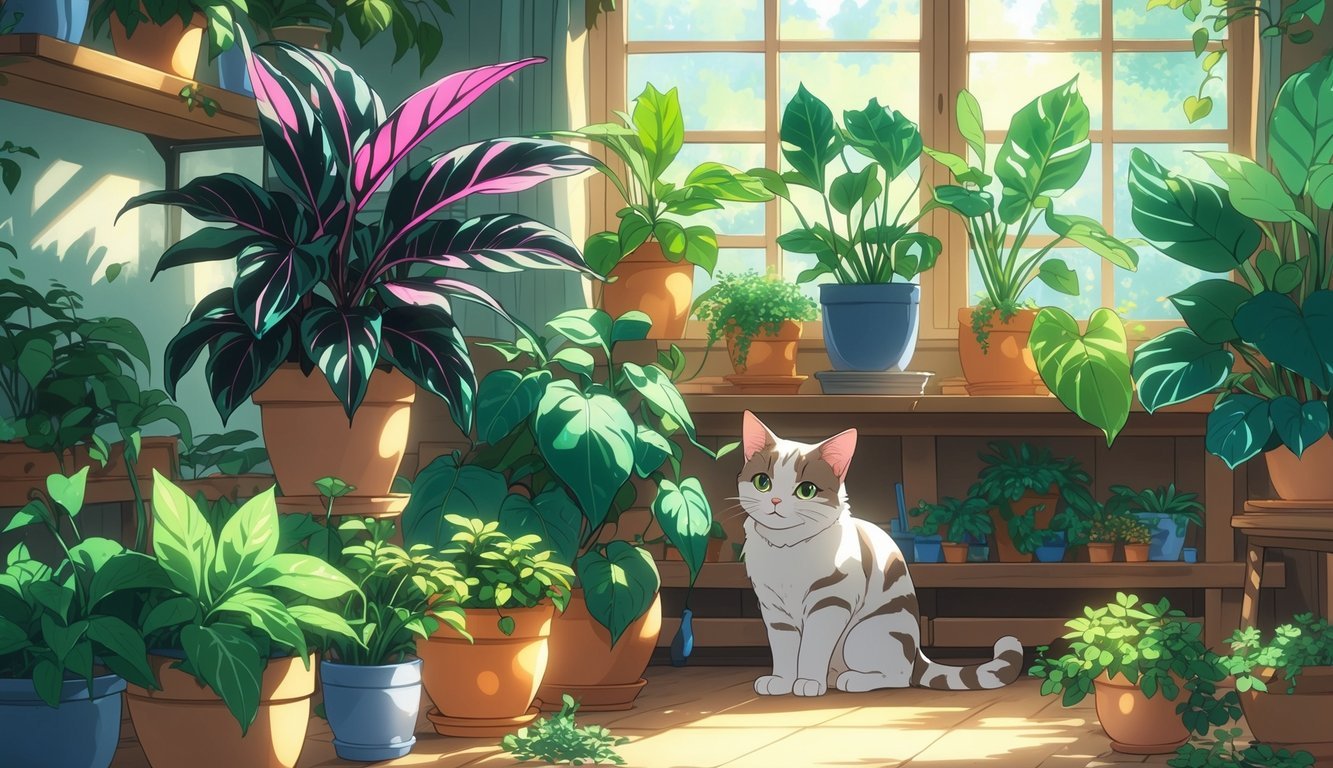
Prayer Plant (Maranta leuconeura) is safe for your cat. If your cat nibbles or paws at it, you don’t have to panic.
The leaves fold up at night and spread out during the day, which is how it got its name. Watching that movement adds a bit of fun to your space.
Prayer plants have bold green leaves with red or yellow patterns. They stay compact, so they’re easy to put on shelves or tables.
They like bright, indirect light and slightly moist soil. Water regularly, but don’t let the pot get soggy.
If your cat is extra curious, you might want to keep the plant on a higher shelf. It’s safe, but less rough play means your plant stays looking good.

Cast Iron Plant is about as low-maintenance as it gets. It’s totally safe for cats, so you don’t need to stress if your pet checks it out.
This plant is great if you want something that can handle low light, missed waterings, and a bit of neglect.
Its dark green leaves stand upright and give your room a simple, clean look. You can tuck it into corners or spots where other plants wouldn’t survive.
It grows slowly, so you won’t be repotting it much.
If you’re new to plants, Cast Iron Plant is a forgiving, pet-friendly way to start.
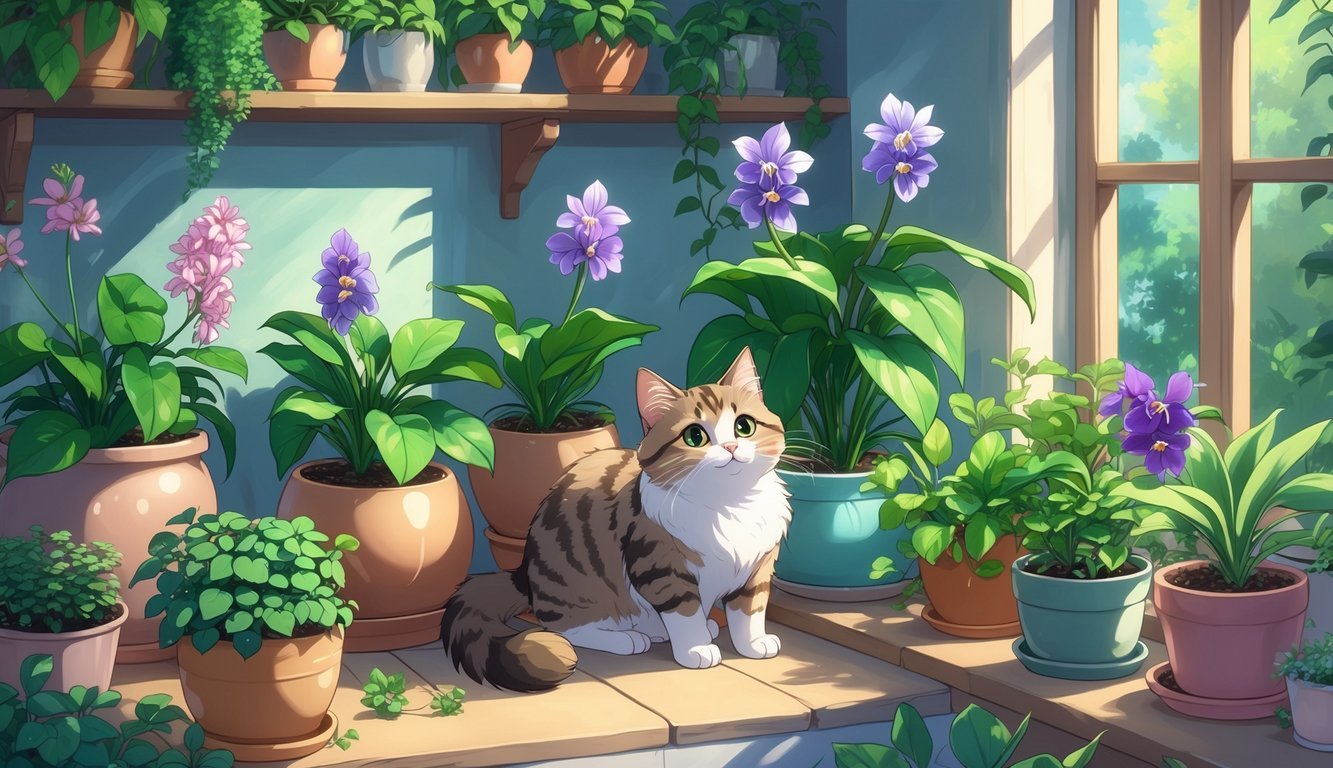
African violets are a safe way to add color to your home. They’re non-toxic, so a curious cat won’t get sick from a nibble.
These little plants bloom in purple, pink, or white and don’t take up much space.
Give them moderate light and average humidity. They’re happy in warm indoor spots, so they fit easily into most homes.
Even though they’re safe, keeping them out of reach helps protect both the plant and your cat.
With just a bit of care, African violets can bloom all year.

Friendship Plant (Pilea involucrata) is a good pick if you’ve got cats at home. It’s non-toxic, so a few nibbles won’t hurt your pet.
The plant has soft, crinkly green leaves that add texture to your space. It stays pretty compact, so you can tuck it onto shelves or small tables.
It grows best in bright, indirect light and likes the soil just a bit moist. Don’t let it get soggy, and it’ll keep growing.
Because it stays small, you can group it with other cat-safe plants for a cozy indoor garden. It’s a stress-free addition for anyone with pets.

If you live with cats, the baby rubber plant—Peperomia obtusifolia—makes a safe pick. You won’t have to stress if your cat nibbles on the leaves, since this plant isn’t toxic for pets.
Its thick, shiny leaves really stand out and always seem to look neat and fresh. Because it stays pretty small, you can fit it just about anywhere without it taking over.
The plant’s compact size means you can pop it onto a shelf, windowsill, or even your work desk. It’s nice to have options, right?
Taking care of a baby rubber plant doesn’t get much easier. It likes bright, indirect sunlight but honestly, it can handle lower light too.
Just water it when the soil feels dry. That’s about it—super low-maintenance.
Sometimes, it’ll surprise you with little white flower spikes, but most folks keep it around for those glossy leaves. If you want a pet-safe, easy-care plant, this one fits right into a cat-friendly home.

When you bring plants into your place, you’re also bringing them into your cat’s territory. Some plants can upset your cat’s stomach, irritate their skin, or cause bigger problems.
Others are totally safe, so it’s worth knowing the difference. That way, you can keep your cat healthy and still enjoy some greenery indoors.
A lot of popular houseplants just aren’t safe for cats. Lilies are probably the worst—tiny amounts can badly damage your cat’s kidneys.
Aloe vera might help people, but it’ll make your cat throw up and feel sick. Dieffenbachia (Dumb Cane) can hurt your cat’s mouth and throat, making eating painful.
Here are a few more to watch out for:
Cats love to chew leaves, sometimes just out of curiosity. Even a tiny bite can be risky, so it’s best to skip these plants or keep them far from your pets.
Cats process chemicals differently than we do—and even differently from dogs. Their livers don’t have all the enzymes needed to break down certain toxins, so they’re extra sensitive to stuff in plants.
So, a plant that seems harmless to you might really mess up your cat. That’s something people often forget.
Chewing leaves is just part of being a cat. Some do it for fun, others for their stomach, and some just like the feel.
You probably can’t stop your cat from trying, so the best move is to pick plants that won’t hurt them if they take a bite.
Even safe plants can give your cat a mild tummy ache if they eat a lot, but that’s usually nothing serious. Still, it’s another reason to stick with cat-friendly options.
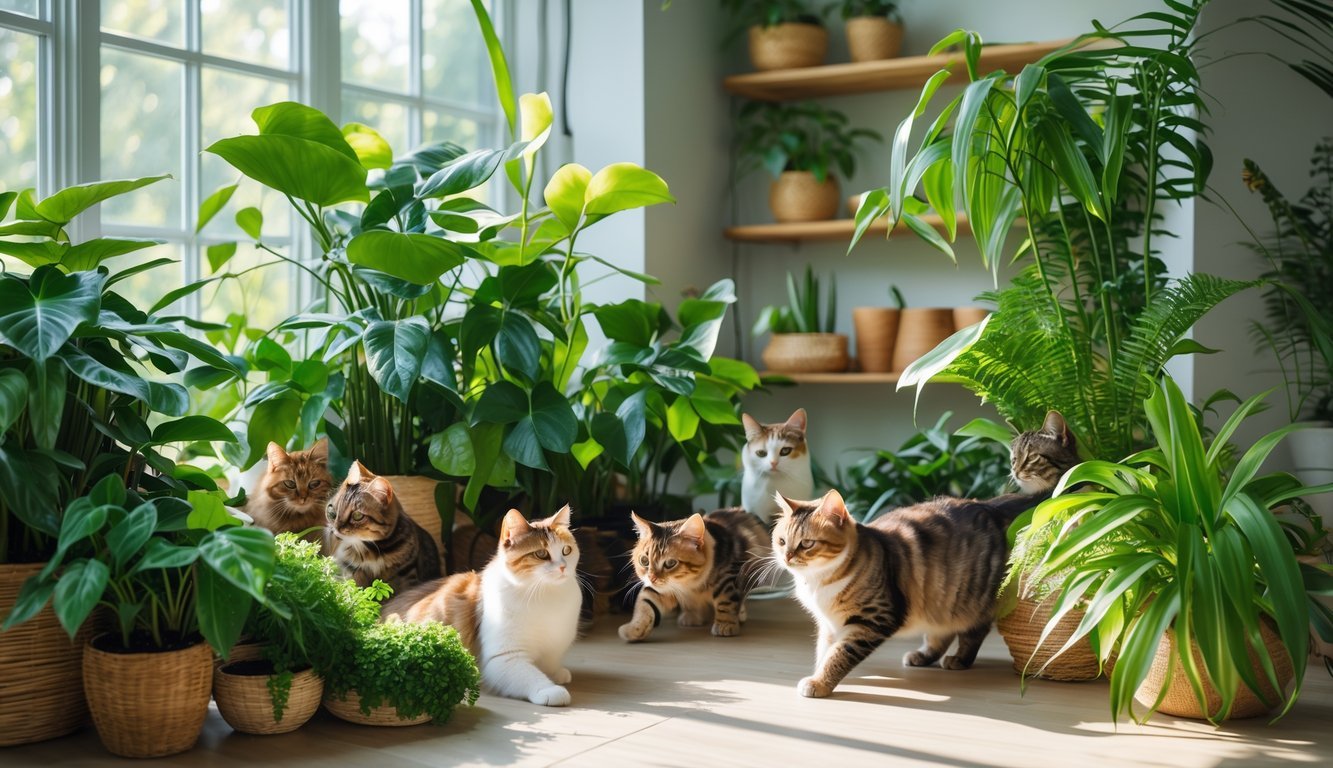
You can have thriving plants and keep your cat safe by choosing the right containers and setting a few boundaries. A little planning goes a long way and helps stop your cat from chewing or knocking things over.
The planter you use makes a difference for safety and stability. Heavy ceramic or concrete pots are tough for cats to tip over, unlike those lightweight plastic ones.
If you like lighter planters, pick ones with wide bases so they won’t wobble. That small detail can save a lot of mess.
Skip planters with sharp edges or anything fragile, like thin glass. They break too easily and can be dangerous.
You might want to try hanging planters or wall shelves too. They keep plants out of reach and free up floor space.
Don’t forget about drainage. Use pots with holes and saucers to catch water, so you won’t end up with spills that attract your cat or damage your floors.
To keep soil in place, toss on some decorative rocks or mesh. That also makes digging less tempting for curious cats.
Quick checklist for safe planters:
Even if you pick out only safe plants, you still have to teach your cat to leave them alone. Try putting your plants somewhere less tempting, like up high on shelves or in hanging baskets.
Cats always seem curious, so they’re probably going to poke around at first. That’s just how they are.
Try some positive reinforcement. If your cat ignores the plants, hand out a treat or maybe play with them for a bit.
Redirect their attention with something better, like a scratching post, a patch of cat grass, or a favorite toy. Honestly, they just want something fun to do.
You can also make plants less interesting. Spritz a little water if they get too close, or use a citrus-scented spray—most cats really aren’t fans of that smell.
Some people put aluminum foil or double-sided tape around the base of pots. It’s not pretty, but it can stop cats from climbing or digging.
Stick with it. If you allow your cat to nibble on one plant but not the others, they’ll just get mixed signals.
Keep the rules the same for every plant in your space. It makes things easier for both of you.